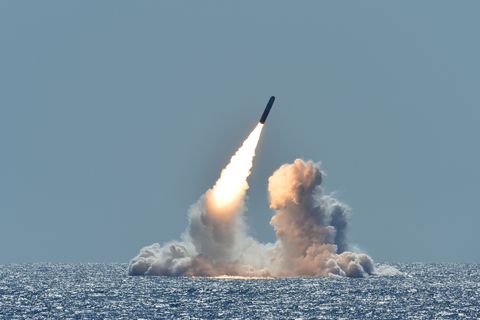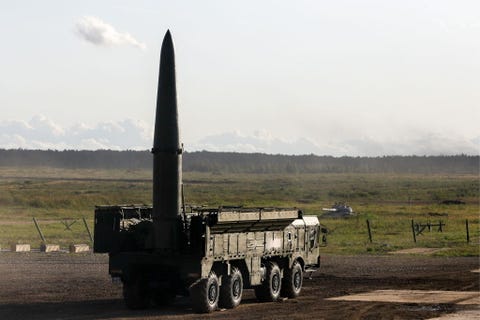Trump Administration Begins Production of New Nuclear Weapon
The W-76-2 weapon has a smaller bang than most nukes, but it’s a nuke just the same.
By Kyle Mizokami
U.S. NAVY PHOTO BY MASS COMMUNICATION SPECIALIST 1ST CLASS RONALD GUTRIDGE/RELEASED
The Trump Administration is racing to field a new nuclear weapon designed to counter Russia and enhance nuclear deterrence.
The W-76-2 warhead will be delivered to the U.S. Navy for deployment on ballistic missile submarines in late 2019. Proponents claim the new warhead will enable the U.S. to respond to Russian nuclear weapons proportionately, but critics claim the W-76-2 is just another nuclear weapon and similarly dangerous.
The W-76-2 is an adaptation of the older W-76-1, currently fitted to Trident D-5 submarine-launched ballistic missiles aboard the Navy’s Ohio-class submarines. The U.S. Navy maintains several Ohio subs on patrol at any time. Current estimates put the force at ten submarines, with a total of 212 Trident D-5 missiles and 945 W-76-1 warheads on call at any time. The U.S. will field an unknown number of the new warheads.
The W-76-2 is designed to have a far smaller explosive yield than other nukes. While its predecessor makes about 100 kilotons of boom, the W-76-2 has an estimated yield of five to seven kilotons. (A kiloton is defined as the equivalent of 1,000 tons of TNT. The bomb dropped on Hiroshima, for example, had a yield of 15 to 17 kilotons, meaning the new nuke would be less powerful than that.)
The U.S. government's 2018 Nuclear Posture Review (NPR) claims that Russia is lowering its threshold for using low-yield nuclear weapons in wartime and warned that the U.S. must move to match this capability. “Russia’s belief that limited nuclear first use,” the NPR states, “potentially including low-yield weapons, can provide such an advantage is based, in part, on Moscow’s perception that its greater number and variety of non-strategic nuclear systems provide a coercive advantage in crises and at lower levels of conflict.”

Russian Iskander-M nuclear-capable short-range ballistic missile.
GETTY IMAGES/MIKHAIL TERESHCHENKO
The W-76-2 is America’s response to Russia’s alleged change in nuclear thinking. Consider a hypothetical conventional war between the United States and Russia. If the report is to be believed, then Russia could use or threaten to use nuclear weapons, particularly low-yield ones, if it started losing. The W-76-2 seeks to demonstrate to Russia that the U.S. will be able to match the use of low-yield nuclear weapons without escalating to larger ones, like the original W-76-1, leaving the Russians with no advantage in using nukes to begin with.
But critics argue the NPR is mistaken, and that Russian nuclear policy has not changed. A nuclear weapon is a nuclear weapon, and the use of one by either side will invite the other side to use its own nukes, potentially leading to all-out nuclear war. In other words, the doctrine of assured destruction still holds. As a result, nuclear war remains as unlikely as it has ever been. Critics also contend that the cost of creating the new weapons is ultimately unnecessary and wasteful.
According to the National Nuclear Security Administration, the first W-76-2 is under construction at the Pantex Plant in Texas, the primary site for the assembly, disassembly, testing, and evaluation of nuclear weapons in the United States. The first warhead should reach the U.S. Navy by late 2019.
Source: NPR, Defense News
No comments:
Post a Comment